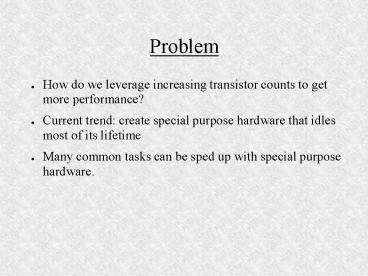Problem - PowerPoint PPT Presentation
Problem
Construct hardware structures and analyze performance characteristics on today's ... Much research into locating parallelism (ie: VLIW, super computer) ... – PowerPoint PPT presentation
Title: Problem
1
Problem
- How do we leverage increasing transistor counts
to get more performance? - Current trend create special purpose hardware
that idles most of its lifetime - Many common tasks can be sped up with special
purpose hardware.
2
Proposed Solution
- Dynamically reconfigurable hardware - FPGAs
- Standard CPU handles most execution
- Common instruction blocks compiled to FPGA
hardware - Greatly leverages parallelism perfect for inner
loops - As transistor count goes up, FPGA size can scale.
3
Means of Evaluation
- Profile to locate parallelism and most common
execution paths in sample programs (Amdahl's
Law). - Construct hardware structures and analyze
performance characteristics on todays FPGA
compared to a regular CPU. - Estimate FPGA startup time
- Calculate speedup for a given architecture and
programming model
4
Related Works
- Much research into locating parallelism (ie
VLIW, super computer) - Our attempts at exploiting inner loop
parallelism are in some ways similar to vector
processors. - GARP of Berkeley A True Implementation
Compilation techniques - Cell architectures
5
Desired Results
- FPGA startup time can be offset by speedup for an
architecture and programming model of manageable
complexity - Many commonly used programs will benefit
- Speedup justifies chip space in light of
alternative uses (ie more cache, more CPUs) - Cost of production estimates are no greater than
devices already providing similar performance
PowerShow.com is a leading presentation sharing website. It has millions of presentations already uploaded and available with 1,000s more being uploaded by its users every day. Whatever your area of interest, here you’ll be able to find and view presentations you’ll love and possibly download. And, best of all, it is completely free and easy to use.
You might even have a presentation you’d like to share with others. If so, just upload it to PowerShow.com. We’ll convert it to an HTML5 slideshow that includes all the media types you’ve already added: audio, video, music, pictures, animations and transition effects. Then you can share it with your target audience as well as PowerShow.com’s millions of monthly visitors. And, again, it’s all free.
About the Developers
PowerShow.com is brought to you by CrystalGraphics, the award-winning developer and market-leading publisher of rich-media enhancement products for presentations. Our product offerings include millions of PowerPoint templates, diagrams, animated 3D characters and more.































